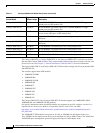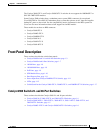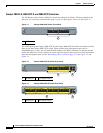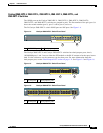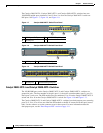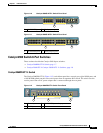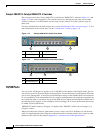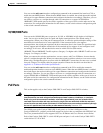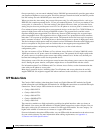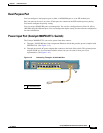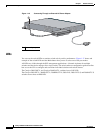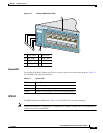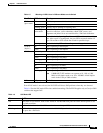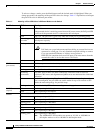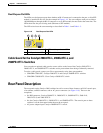
1-10
Catalyst 2960 Switch Hardware Installation Guide
OL-7075-05
Chapter 1 Product Overview
Front Panel Description
On a per-port basis, you can control whether Catalyst 2960 PoE port automatically provides power when
you connect an IP phone or an access point. The device manager, Network Assistant, and the CLI provide
two PoE settings for each 10/100 PoE port: Auto and Never.
When you select the Auto setting, the port provides power only if a valid powered device, such as an
IEEE 802.3af-compliant powered device, a Cisco pre-standard IP phone, or a Cisco pre-standard Cisco
access point, is connected to it. The Auto setting is the default. However, when you select the Never
setting, the port does not provide power even if a Cisco IP
phone or an access point is connected to it.
Cisco enhanced power negotiation allows some powered devices, such as the Cisco 7970G IP Phone, to
operate in high-power mode on Catalyst 2960 PoE switches. The powered device and the switch
negotiate through power-negotiation Cisco Discovery Protocol (CDP) messages for an agreed-upon
power-consumption level. The negotiation allows a high-power Cisco powered device that consumes
more than 7 W to operate at its highest power mode. The powered device first boots up in low-power
mode, consumes less than 7 W, and negotiates to obtain enough power to operate in high-power mode.
The device changes to high-power mode only when it receives confirmation from the switch. High-power
devices can operate in low-power mode on switches that do not support power-negotiation CDP.
For information about configuring and monitoring PoE ports, see the switch software
configuration
guide.
You also can connect a Cisco IP Phone or Cisco Aironet Access Point to a Catalyst 2960 PoE switch
10/100 port and to an AC power source for redundant power. The powered device might switch to the
AC power source as its primary power source upon being connected to it. In that case, the PoE port
becomes the backup power source for the powered device.
If the primary source fails, the second power source becomes the primary power source to the powered
device. During the power transfer, an IP phone might reboot or reestablish link with the switch.
For information about Cisco IP Phones and Cisco Aironet Access Points, see the documentation that
came with your IP
phone or access point.
Many legacy powered devices, including older Cisco IP phones and access points that do not fully
support IEEE 802.3af, might not support PoE when connected to the switches by a crossover cable.
SFP Module Slots
The Catalyst 2960 switches (other than those listed) use Gigabit Ethernet SFP modules for Gigabit
uplink connections and 100-Megabit SFP modules for 100-Megabit connections to establish fiber-optic
connections. These Catalyst 2960 switches do not have an SFP module slot:
• Catalyst 2960-24LT-L
• Catalyst 2960-24TT-L
• Catalyst 2960-48TT-L
• Catalyst 2960PD-8TT-L
• Catalyst 2960-24-S
The transceiver modules are field-replaceable, providing the uplink interfaces when you insert an
SFP
module. You can use the SFP modules for Gigabit uplink connections to other switches. You use
fiber-optic cables with LC connectors to connect to a fiber-optic SFP module. You use Category 5 or
higher cable with RJ-45 connectors to connect to a copper SFP module.
For more information about these SFP modules, see your SFP module documentation or the release notes
for your switch software. For more information about cabling requirements, see
Appendix A,
“Connector and Cable Specifications.”



